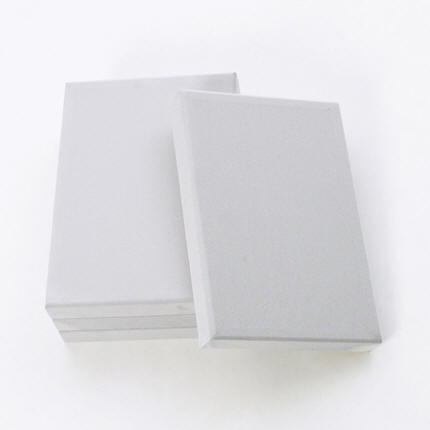
You are reading the older HTML site
Positive Feedback ISSUE
41january/february 2009
cathedral sound
Acoustic Panels - A second take
as reviewed by Bruce Kinch

|
I read Francisco Duran's review of the Cathedral Sound panels with great interest. Although my listening room is quite different from his in almost every characteristic, I too have found the panels effective. I have also procrastinated on writing about them, partly because of related system changes, but also due to the expectation (as yet un-realized, due to unresolved domestic policy disputes) of moving the audio gear into an alternative space where the effects of the panels could be more usefully compared and assessed for the readership. Francisco has basically done that: his is a 12 x 20 "shoebox" room, rather close to the Cardassian-Fibonacci ideal of 8 x 13 x 21. That suggests the bass frequency standing waves or Eigenmodes will be reasonably well distributed. His complications include a glass sliding door, and a large opening to another space, but the room itself appears to be of standard drywall on stud construction for walls and ceiling at least. Such frame construction is subject to significant bass leakage, as anyone who has lived in an apartment adjacent to a subwoofer (or just a big dog) can attest.
By contrast, my space is a nightmare half-cube, approximately 9 x 18 x 18.5. That is a formula that guarantees the standing waves will overlay each other and exaggerate the response peaks and valleys from bass through lower midrange. To complicate matters, the house is constructed of adobe bricks, dense dried-mud slabs about 12" x 18". There is zero bass leakage through adobe, and very little at higher frequencies. The floor is uneven tile over concrete slab. The ceiling has the traditional New Mexico exposed round beams (or vigas), the space between them coved plaster. The square listening space is actually 2/3 of the adobe outer structure, the remainder taken up by a bathroom and a hallway leading to the rest of the house. Opposite the stud and drywall bathroom wall on the left is a large picture window on the right.
Empty, the room had all the acoustic charm of a tile shower stall. Because the room serves double duty as our guest bedroom, any acoustic treatment had to be discreet. Tube traps and the like were vetoed. A floor rug and pad, plus a daybed to the left and a sleep-sofa to the right (both with ample pillows) provide HF absorption. Slap echo and first reflections left and right are handled with hanging (faux) Native American rugs and heavy drapes on the window. Diffusion is provided by bookshelves, furniture, and the coved and beamed ceiling.
When I initially tried the Cathedral Sound panels, I was under-whelmed. They did not do what I had expected of a "Bass Trap"—a broad attenuation of bass level from mid-bass down. With the ATB Pro PC Audio Analyzer system I reviewed in Issue 35 (link), I could see a drop at around 30 Hz, not all that different from what I could achieve by de-pressurizing the room by opening a door or window, but they were clearly doing something. Of course, the ATB works from a continuous pink noise sample, not an impulse that would reveal information about reverb time and decay. I could hear a difference, but it wasn't a solution to the primary problem, which was taming the room's bass modes, and the difficulty of finding an optimal loudspeaker/listening chair arrangement. To keep things simple, I took the panels down (they hang on ordinary finishing nails) and set them aside and started moving speakers and furniture around.
The room (and the ceiling in particular) had restricted loudspeaker options. Wide dispersion dome tweeters, especially those on sloping baffles, generated multiple ceiling reflections that destroyed imaging, so limited dispersion systems were the priority. Full range ribbons and electrostats struggled in the thin air at our 5000' altitude. Maggies might have worked, but were vetoed as visually intrusive. Ultimately I settled on Amphion Xenons, which feature wave-guide limited tweeter dispersion as well as a degree of bass level control. With useful output down to the mid 20's, careful positioning was needed. I included a graph of the Xenons' excellent response in this problematic room with my review of the ATB.
Even with the overall frequency response smoothed out, a degree of congestion remained. Much of the articulation aspect of the congestion was addressed with cable upgrades, in particular the Tel Wire power cords reviewed in Issue 39 (link) that effectively brought the components' power supplies uniformly "up to speed". What remained seemed most likely the stubborn acoustics problems, and thus the way that the adobe walls sustained reverb became suspect.

Professional acousticians working with large spaces (concert halls, theaters, and industrial/commercial environments) give much more attention to reverberation issues than do audiophiles. Small room acoustic treatments for HF absorption and diffusion are usually more crucial and common. Audiophile "Bass Traps" tend to be very large because of the amount of material needed to absorb lower frequencies. The petite Cathedral Sound panels are not sound absorbers in the usual sense. They operate on the venturi principle, i.e., that fluids and gases speed up when forced through a small opening (and vice versa). In essence, a bass tone represents a compression (and rarefaction) of the air at a given frequency. The maximum intensity of the bass standing wave buildup occurs in the corners where walls, ceilings, and floors meet at frequencies determined by the room dimensions. When a Cathedral Sound panel is so positioned, the vibrating air is forced through the small holes into a miniature labyrinth of the perforated boards. This causes the velocity to change, creating turbulence, self-cancellation and conversion of sound energy to heat at the molecular level. This "de-phasing" reduces the intensity of low frequency room modes and reverberation.
In other words, we are talking simple physics here, not voodoo audiohype. While the application is novel, the implementation is straightforward, and the manufacturer is to be commended for not even trying to disguise the "works" by wrapping the grill cloth around the backside. Each panel appears to be a stack of generic "pegboard", offset and slightly separated, and enclosed in a frame. With a modicum of woodworking skills, one could probably knock off the design, although it would be a little more complicated than the common practice of wrapping some foam or fiberglass in a WAF-friendly fabric and calling it a "room treatment". But why bother? You'll probably do more harm to your hearing running the table saw for an hour or two.
Naturally, my room also presented unusual problems for installing the Cathedral Sound panels. When I described the room to Robert Stein of Ultra Systems, he noted that to function properly, the panels must lie flat against the surface they are mounted on without gaps. Three of my room's walls are simple white-washed and quite irregular raw adobe brick. Charming, but definitely unsuitable. So I could not install a symmetrical set as Francisco did. Working from the useful Eigenmode calculator at http://www.hunecke.de/en/calculators/room-eigenmodes.html, I placed three panels on the one smooth wall, one at the top front corner, a second half way down in the corner, and a third at the wall's midpoint near the ceiling. For the fourth panel, I got creative. Robert Stein had also mentioned the panels would work on a smooth ceiling (nope) or floor (nope, again). Although my Nottingham Analogue turntable sits atop a Townshend Sink isolation base, I realized the equipment rack centered on the front wall was in a bass mode zone. The fourth Cathedral Sound panel simply lies directly under the rack on an 18" sq floor tile with three plastic furniture pads coupling it to the uneven saltillo tile floor. Thus, in a very contrary room, I was able to place panels at pressure nodes for the width, depth and height Eigenmode fundamentals and 1st harmonics (the mid-wall units). In my room, these are at roughly 30, 60, and 125 Hz.
When I re-introduced the Cathedral Sound panels into the room, I heard very much the same sorts of improvements as Francisco describes, a deeper and more focused sound stage, better image specificity, improved bass pitch definition, and so on. In particular, the clarity of the various instrumental lines in crescendo passages was audibly improved. In this regard, the Reference Recording CD "Tutti", a disc full of orchestral excerpts loud, busy, and very well recorded was particularly useful. The level of improvement was on the order of a cable upgrade, but by being an improvement by subtraction, never drew attention to itself. There are other audiotweaks that affect the reverberant field in different ways (the Argent Room Lens and Shakti Hallographs, for example), but they tend to be both more expensive and visually intrusive.
Would the Cathedral Sound panels work in your installation? If you have a subwoofer in your home theater that messes up the other channels' articulation when the action gets noisy, probably. If the stereo image collapses or vocals lose intelligibility when your system is cranking with sustained bass-heavy program, probably. If your speakers go lower than a smallish room can support, probably. But they are not a magic cure-all. If your primary problems are above the bass range, look elsewhere. With proper attention to speaker placement, a sensible balance of absorption and diffusion in the room, and suitable surfaces for placement, they can be the icing on the audiocake. Recommended. Bruce Kinch
Cathedral Sound Panels
Retail: $179.95 a pair
Ultra Systems
web address:
www.ultrasystem.com

